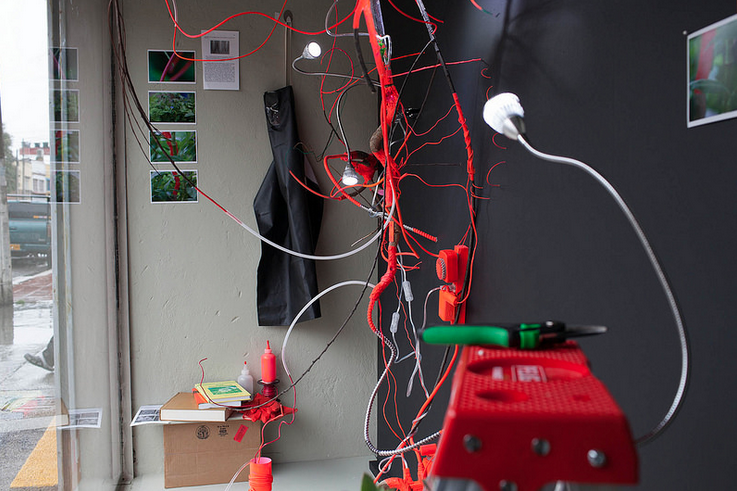Gabinete # 4
Arboricultura Especulativa, cuarta versión del programa Gabinete, es una instalación escultórica realizada por la artista estadounidense Ellie Irons (California, 1981), en donde hace evidente su interés por la biología sintética y las plantas invasoras
Las piezas escultóricas, que brotan de las paredes, piso y techo como una suerte de cyborg vegetal, están conformadas por ramas de la planta invasora Celastro (Celastrus orbiculatus), dispositivos electrónicos y cables que albergan a su vez una pequeña colonia de plántulas de Aranto o Espinazo del Diablo (daigremontiana Kalanchoe), una planta tóxica, de rápida reproducción y fácil adaptación a los cambios climáticos y ambientales causados por el calentamiento global.
Arboricultura Especulativa escenifica una especie de laboratorio para el estudio de la vida vegetal generada sintéticamente (o, inclusive, una sala de cuarentena para una especie invasora fuera de control), que hace a pensar acerca de la rápida evolución de la modificación genética y de la forma en que hoy en día los organismos se expanden más allá de sus geografías y ecosistemas. De esta manera, la artista abre una serie de interrogantes acerca del origen de esta estructura- mitad vegetal, mitad electrónica- que vaticina un posible futuro en el cual las plantas y los dispositivos tecnológicos coexistan en un mismo organismo.
—
Capinet #4: Ellie Irons, Speculative Aboricultura
Speculative Arboriculture, the fourth Cabinet, is a sculptual instalation, made by the US-artist Ellie Irons (California, 1981). The work is about synthetic biology and invading plants.
The sculptures which sprout from the walls, floor and roof like a vegetable cyborg, are shaped by branches of the invading plant Celastro (Celastrus orbiculatus). Electronic devices and cables accomodate a small plantation of Aranto or Espinazo del Diablo (daigremontiana Kalanchoe), a poisonous plant that reproduces itselve rapidly and that easily adapts the climate and environmental changes caused by global warming.
Speculative Arboriculture stages a laboratory type for studying vegetable life that is generated synthetically (or in a quarantine room for invading species out of control) that investigates the rapid evolution of the genetic modification and that the organisms expand out of its geografiy and its ecosystems, nowadays. So, the artist asks a serie of questions about the origin of the composition – half vegetable, half electronic – that predicts a possible future in which plants and technologigal devices coexist in the same organism.
